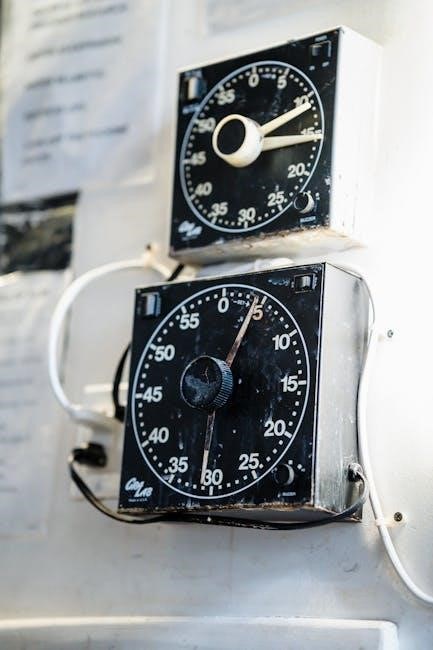Welcome to the Marine Air Systems Control Panel Manual․ This guide provides essential information for installing, operating, and maintaining your marine air conditioning system’s control panel effectively․ It ensures safe and efficient use of the system, covering key functions, safety precautions, and troubleshooting tips․ Read this manual thoroughly to optimize your marine air system’s performance and longevity․
1․1 Overview of Marine Air Systems
Marine air systems are essential for maintaining a comfortable environment on boats and ships․ These systems include air conditioning, ventilation, and heating, ensuring optimal temperature and air quality․ Key components like chillers, Fancoil units, and ventilation fans work together to regulate cabin climates․ The control panel acts as the central command center, integrating sensors, controllers, and user interfaces to monitor and adjust system operations․ Modern marine air systems also incorporate advanced features such as automation and remote monitoring for enhanced efficiency․ Proper installation, maintenance, and operation of these systems are crucial for performance, safety, and energy efficiency․ This manual provides detailed guidance to help users understand and manage their marine air systems effectively․
1․2 Importance of the Control Panel in Marine Air Systems
The control panel is a critical component of marine air systems, serving as the central interface for monitoring and controlling system operations․ It integrates sensors, controllers, and user interfaces to ensure precise temperature regulation, air quality management, and energy efficiency․ The control panel allows users to adjust settings, monitor performance, and troubleshoot issues, ensuring optimal system functionality․ Its user-friendly design simplifies complex operations, making it accessible for operators to manage the marine air system effectively․ Additionally, the control panel enhances safety by providing real-time data and enabling emergency shutdowns when necessary․ Proper use of the control panel is essential for maintaining system performance, reducing energy consumption, and extending the lifespan of marine air systems․
1․3 Purpose of the Manual
This manual is designed to provide comprehensive guidance for the installation, operation, and maintenance of the marine air systems control panel․ It serves as a reference for users to understand system functions, safety protocols, and troubleshooting procedures․ The manual ensures that operators can maximize the efficiency and longevity of their marine air systems․ By following the instructions outlined, users can safely and effectively manage their system, addressing common issues and optimizing performance․ This guide is intended for both novice and experienced users, offering clear, step-by-step instructions to ensure smooth operation and maintenance of the control panel and associated marine air systems․

Understanding the Control Panel Components
The control panel comprises essential components like display panels, push buttons, LED indicators, sensors, and controllers․ These elements work together to regulate and monitor marine air systems efficiently․
2․1 Display Panel and User Interface
The display panel serves as the central interface for monitoring and controlling marine air systems․ It features a user-friendly design with a digital screen showing temperature, airflow, and system status․ The interface includes intuitive buttons for mode selection, temperature adjustment, and automation features․ LED indicators provide visual feedback on operational status, errors, and maintenance alerts․ The display panel is typically mounted in an accessible location, ensuring easy operation․ It may also include advanced features like touchscreens or remote connectivity, enhancing user experience․ Proper understanding of the display panel is crucial for efficient system management and troubleshooting․ Refer to the manual for detailed instructions on utilizing its functions effectively․
2․2 Push Buttons and LED Indicators
The control panel features a set of push buttons and LED indicators for easy operation and system monitoring․ Push buttons allow users to select modes, adjust settings, and activate specific functions․ LEDs provide visual feedback, indicating system status, active modes, errors, or maintenance alerts․ Common LEDs include power indicators, mode selectors, and fault alarms․ The buttons are designed for intuitive operation, with clear labels or symbols for functionality․ LEDs are color-coded to differentiate between normal operation (green) and potential issues (red or yellow)․ These components ensure seamless interaction with the marine air system, enabling quick troubleshooting and adjustments․ Proper understanding of their functions is essential for efficient system control and maintenance․ Always refer to the manual for specific button and LED configurations․
2․3 Sensors and Controllers
The control panel integrates advanced sensors and controllers to monitor and regulate marine air systems․ Temperature sensors detect ambient and setpoint temperatures, ensuring precise climate control․ Pressure sensors monitor refrigerant levels and airflow, while humidity sensors optimize dehumidification․ Flow rate sensors track air circulation for consistent comfort․ Controllers process data from these sensors to adjust compressor speed, fan operation, and valve positions․ They also manage automation features, such as automatic mode switching and energy-saving routines․ The system’s microcontroller ensures seamless communication between components, maintaining optimal performance․ Sensors and controllers work together to provide real-time feedback, enabling efficient operation and proactive fault detection․ Regular calibration and maintenance of these components are crucial for reliable system function and longevity․ Always refer to the manual for specific sensor and controller configurations and troubleshooting guidelines․
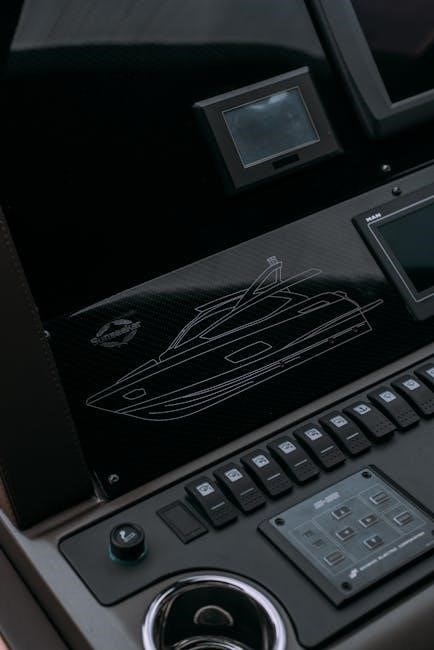
Installation and Setup of the Control Panel
Installing the control panel involves preparing the mounting surface, securing the panel, and connecting electrical and pneumatic components․ Ensure proper alignment and tighten all fasteners securely․ Connect power supplies and sensors according to the wiring diagram․ Refer to the manual for specific instructions on configuring automation features․ Test the system post-installation to confirm functionality․ Proper setup ensures safe and efficient operation of your marine air system․
3․1 Pre-Installation Checks
Before installing the control panel, ensure all components are undamaged and compatible with your marine air system․ Verify the power supply matches the panel’s voltage requirements․ Inspect the mounting surface for stability and ensure proper ventilation to prevent overheating․ Check that all sensors, wires, and connectors are intact and free from corrosion․ Review the system’s specifications to confirm compatibility with your vessel’s electrical and pneumatic infrastructure․ Ensure you have all necessary tools and documentation on hand․ Familiarize yourself with safety guidelines to avoid electrical or pneumatic hazards․ Conducting these checks ensures a smooth installation process and prevents potential issues down the line․ Proper preparation is key to a successful setup․
3․2 Mounting the Control Panel
Mounting the control panel requires careful planning to ensure proper functionality and safety․ Choose a location with easy access, away from direct moisture and vibrations․ Use the provided mounting brackets and screws to secure the panel firmly to the surface․ Ensure the panel is level and aligned correctly to prevent operational issues․ If installing on a metal hull, verify that the panel does not interfere with the hull’s structural integrity․ Avoid mounting near obstructions, such as decorative panels or equipment that may block airflow or access․ Once mounted, double-check all electrical connections and test the display to ensure it powers on and functions correctly․ Proper mounting is essential for reliable performance and longevity of the marine air system․
3․3 Connecting Electrical and Pneumatic Components
Connecting electrical and pneumatic components requires precision to ensure proper system operation․ Begin by connecting the power supply to the control panel, ensuring all wires are securely attached to the correct terminals․ Verify that the electrical connections match the system’s voltage requirements․ Next, connect the pneumatic lines to the control panel, ensuring they are tightly secured to prevent air leaks․ Connect sensors and controllers to their respective ports, following the wiring diagram provided in the manual․ After all connections are made, test the system by turning on the power and checking for proper airflow and functionality․ If any issues arise, refer to the troubleshooting section or contact a certified technician․ Proper connections are critical for the system’s performance and safety․

Safety Precautions and Guidelines
Always disconnect power before servicing electrical components․ Handle pneumatic systems with care to avoid leaks․ Follow emergency shutdown procedures if issues arise․ Ensure connections are secure for safe operation․
4․1 Electrical Safety Measures
Electrical safety is critical when working with marine air systems․ Always disconnect the power supply before performing any maintenance or repairs to avoid electrical shocks or injuries․ Ensure all electrical components are properly grounded and insulated․ Use appropriate voltage-rated tools and follow the manufacturer’s guidelines for wiring and connections․ Never override safety devices or bypass circuit breakers, as this can lead to system malfunctions or fires․ Additionally, ensure that all electrical panels are securely closed and labeled correctly․ Regularly inspect wires and connections for signs of wear or damage, and replace them immediately if necessary․ Adhering to these measures ensures a safe operating environment and prolongs the system’s lifespan․
4․2 Handling of Pneumatic and Refrigerant Systems
When handling pneumatic and refrigerant systems, always wear protective gear, including gloves and safety goggles, to prevent injuries․ Ensure proper ventilation in the workspace to avoid inhaling refrigerant fumes․ Follow manufacturer guidelines for handling refrigerants, as improper handling can lead to system leaks or environmental hazards․ For pneumatic systems, inspect tubing and connections for damage before pressurizing․ Never over-pressurize components, as this can cause system failure․ Always shut off the power supply and discharge pressure before performing maintenance․ Use approved tools and follow safety protocols when connecting or disconnecting refrigerant lines․ Properly label and store refrigerants to prevent contamination․ Dispose of refrigerants responsibly, adhering to environmental regulations․ These precautions ensure safe and efficient system operation․
4․3 Emergency Shutdown Procedures
In case of an emergency, such as a system malfunction or refrigerant leak, follow these shutdown steps immediately․ First, locate the emergency stop button on the control panel and press it firmly to halt all operations․ Next, switch off the main power supply to the system at the electrical panel․ If the issue persists, activate the manual override to isolate the pneumatic and refrigerant lines; Ensure all valves are closed to prevent further damage or leakage․ Evacuate the area and ventilate if necessary․ Do not restart the system until a qualified technician has inspected and approved it for safe operation․ Always prioritize safety to avoid accidents and ensure the system remains functional for future use․ Proper emergency shutdown procedures are critical for maintaining the integrity of your marine air systems․
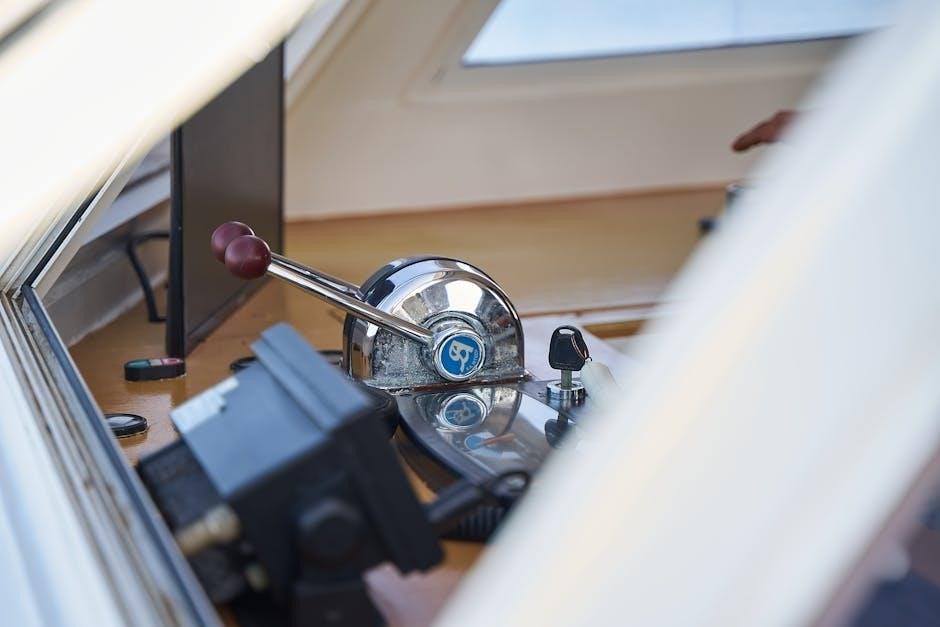
Operating the Marine Air Systems Control Panel
Start by powering on the system via the control panel․ Use the buttons to select desired modes and adjust settings․ Refer to the manual for advanced features operation․
5․1 Basic Operation and Mode Selection
Begin by turning on the marine air system using the power button on the control panel․ The display will light up, indicating the system is active․ Use the mode selection buttons to choose between cooling, heating, or ventilation modes․ The default mode is typically cooling․ Adjust the temperature using the up and down arrows on the panel․ Ensure the air flow is set to your preferred level using the fan speed controls․ The system will automatically adjust to maintain the selected temperature․ Monitor the LED indicators to confirm the mode and operational status․ For optimal performance, refer to the manual for guidance on selecting the appropriate mode based on ambient conditions․ Always ensure the system is set to the correct mode before leaving it unattended․
5․2 Adjusting Temperature and Air Flow Settings
To adjust the temperature, press the up or down arrows on the control panel until the desired temperature is displayed․ The system will automatically adjust to maintain the selected temperature․ For air flow, use the fan speed buttons to increase or decrease the air circulation; Choose from low, medium, or high settings based on your comfort needs․ The LED indicators will show the selected fan speed․ Ensure proper air flow by checking that all vents are open and unobstructed․ For optimal performance, avoid blocking air outlets․ The control panel may also feature an automatic mode that adjusts both temperature and air flow based on ambient conditions․ Always monitor the display to confirm your settings are applied correctly․ Proper adjustment ensures efficient cooling or heating and maintains a comfortable environment on board․ Regular checks on air flow settings can prevent system overloading and maintain energy efficiency․
5․3 Using Advanced Features and Automation
The control panel offers advanced features to enhance your marine air system’s performance․ Use the automatic mode to let the system adjust temperature and air flow based on ambient conditions․ Enable the scheduling feature to set specific times for system operation, optimizing energy use․ Remote access via a smartphone app allows you to control settings even when you’re not on board․ The system also includes smart sensors that detect occupancy and adjust settings accordingly․ For energy efficiency, enable the eco-mode, which reduces power consumption while maintaining comfort․ These automation features ensure seamless operation and personalized comfort․ Regularly update your control panel software to access new features and improvements․ By utilizing these advanced functions, you can enjoy a more convenient and energy-efficient marine air system experience․ Always refer to the manual for detailed instructions on activating and customizing these features․
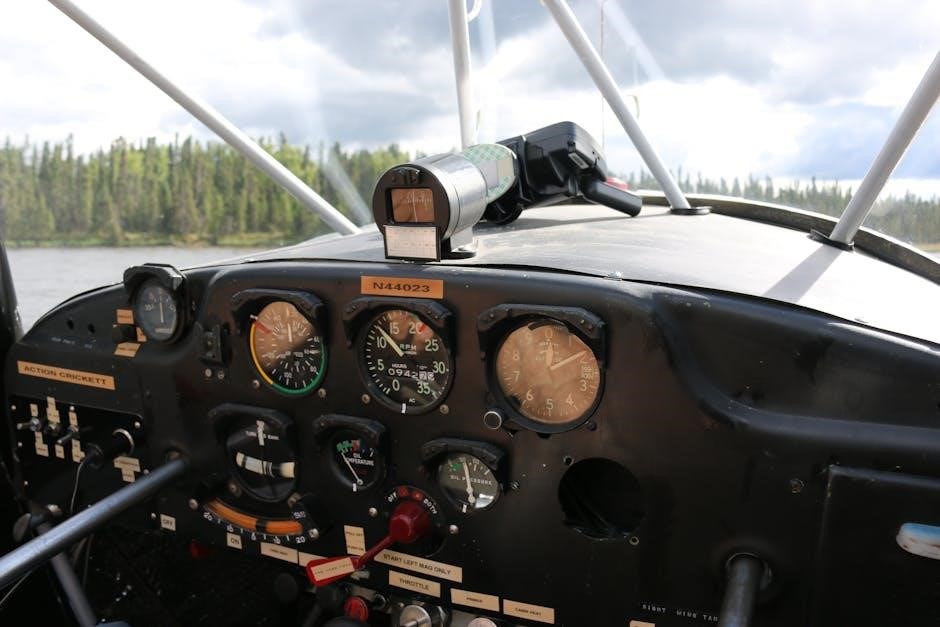
Maintenance and Troubleshooting
Regularly clean filters, inspect sensors, and check for software updates․ Address error codes promptly to prevent system malfunctions and ensure optimal performance․
6․1 Routine Maintenance Tasks
Perform routine maintenance tasks to ensure optimal functionality of your marine air systems control panel․ Begin by cleaning or replacing air filters every 1-3 months to maintain proper airflow and efficiency․ Inspect the display panel and user interface for any signs of wear or damage, ensuring all buttons and LEDs are functioning correctly․ Check electrical connections and wiring for loose contacts or corrosion, as these can lead to system malfunctions․ Additionally, verify that all sensors, such as temperature and pressure sensors, are calibrated and operating within specified ranges․ Regularly update the control panel software to access new features and improvements․ Finally, review the system logs to identify and address any recurring issues promptly․
6․2 Common Issues and Troubleshooting Tips
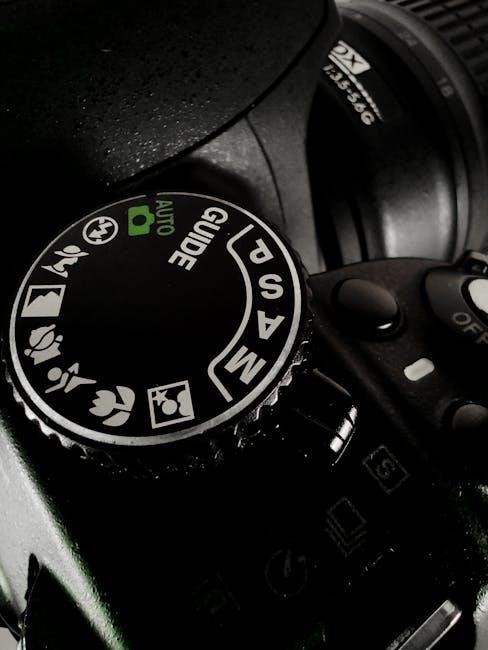
Common issues with marine air systems control panels include the display not lighting up, inconsistent temperature readings, or unresponsive buttons․ If the panel loses power, check the electrical connections and ensure the circuit breaker is not tripped․ For temperature inaccuracies, inspect sensors for damage or blockage and ensure proper calibration․ If buttons are unresponsive, clean them with a soft cloth and verify wiring connections․ Addressing these issues promptly prevents system downtime․ Regularly reviewing system logs can help identify recurring problems early․ Always refer to the manual for specific troubleshooting steps tailored to your system․ By addressing these common issues, you can maintain smooth operation and extend the lifespan of your marine air system․
6․3 Diagnosing Faults in the Control Panel
Diagnosing faults in the marine air systems control panel involves identifying symptoms and tracing their causes․ Common issues include the panel not powering up, incorrect temperature readings, or unresponsive controls․ Start by checking the power supply and circuit breakers if the panel doesn’t light up․ For inaccurate temperature readings, inspect sensors for damage or blockages and ensure proper calibration․ Unresponsive buttons may indicate faulty wiring or corrosion․ Use the system’s diagnostic mode to identify error codes and refer to the manual for specific troubleshooting steps․ Regularly inspect connections and clean components to prevent malfunctions; Addressing faults promptly ensures reliable system operation and prevents further damage․ Always follow safety guidelines when performing diagnostics to avoid electrical or pneumatic hazards․
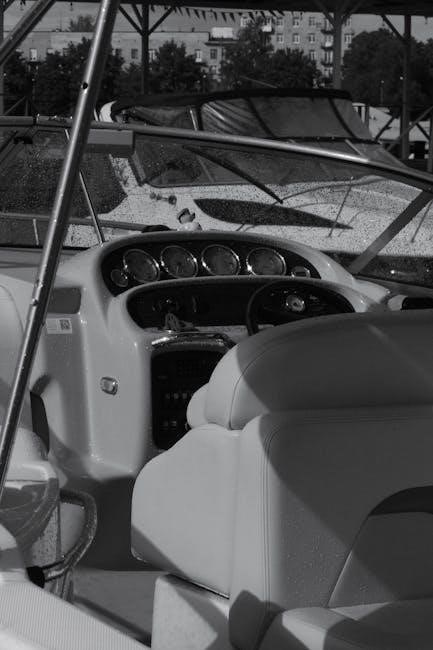
Warranty and Support Information
This section outlines the warranty policy for Marine Air Systems, detailing coverage and duration․ It also provides contact details for customer support and access to online resources․
7․1 Marine Air Systems Warranty Policy
The Marine Air Systems Warranty Policy ensures coverage for defects in materials and workmanship for a specified period․ Typically, the warranty lasts one year from the date of installation, covering parts and labor․ It applies to systems installed and maintained according to the manufacturer’s guidelines; The warranty does not cover damage caused by misuse, improper installation, or failure to adhere to maintenance recommendations․ For detailed terms and conditions, refer to the official warranty document provided with your system․ This policy aims to protect your investment and ensure optimal performance of your marine air conditioning system․
7․2 Contacting Customer Support
For assistance with your marine air systems control panel, contact our customer support team at 954-973-2477 or via fax․ Visit our website for online resources and manuals․ Refer to your product’s manual for specific guidance․ Our support team is available to help with troubleshooting, maintenance, and system optimization․ Ensure you have your system’s model number and installation details ready for efficient service․ This support ensures your marine air system operates at peak performance, providing comfort and reliability․ Reach out to our experts for any inquiries or concerns․
7․3 Accessing Online Resources and Manuals
To access online resources and manuals for your marine air systems control panel, visit the official website and select your product from the dropdown menu․ Download the latest versions of manuals, guides, and technical documents for detailed instructions․ These resources provide comprehensive information on installation, operation, and troubleshooting․ If you encounter issues, contact customer support at 954-973-2477 or via fax for assistance․ Online materials are updated regularly to ensure you have the most current information․ Utilize these resources to maximize your system’s performance and resolve any operational challenges efficiently․ This convenient access ensures you can maintain and optimize your marine air systems control panel effectively․
This manual provides comprehensive guidance for the safe and efficient operation of marine air systems, ensuring optimal performance and longevity․ Review it regularly for best results․
8․1 Summary of Key Points
This manual has provided a detailed overview of marine air systems control panels, focusing on installation, operation, and maintenance․ Key points include understanding system components like displays, sensors, and controllers, ensuring electrical and pneumatic connections are secure, and adhering to safety measures․ Regular maintenance tasks and troubleshooting tips were highlighted to prevent common issues․ The importance of proper setup and user-friendly interfaces was emphasized for optimal performance․ By following the guidelines in this manual, users can ensure their marine air systems operate efficiently, safely, and reliably․ Always refer to the warranty and support information for additional assistance․ Proper use and care will extend the lifespan of your marine air system․
8․2 Final Tips for Optimal System Performance
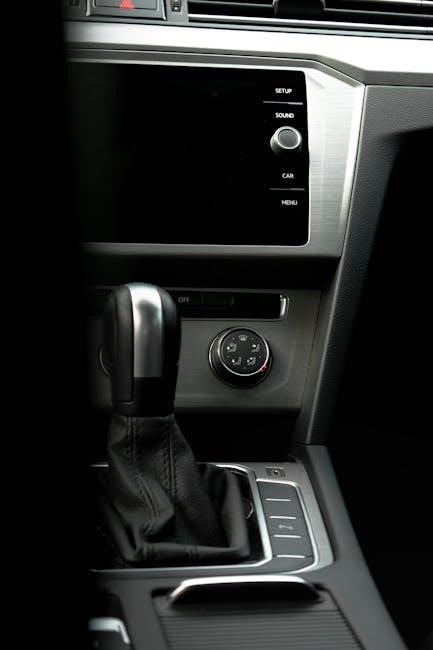
- Always perform regular maintenance to ensure system efficiency and longevity․
- Check electrical connections and pneumatic components periodically for tightness and damage․
- Ensure proper installation of the control panel and related sensors for accurate readings․
- Use genuine parts and follow manufacturer guidelines for replacements and repairs․
- Monitor temperature and airflow settings to maintain comfort and energy efficiency․
- Refer to the manual for troubleshooting common issues before contacting support;
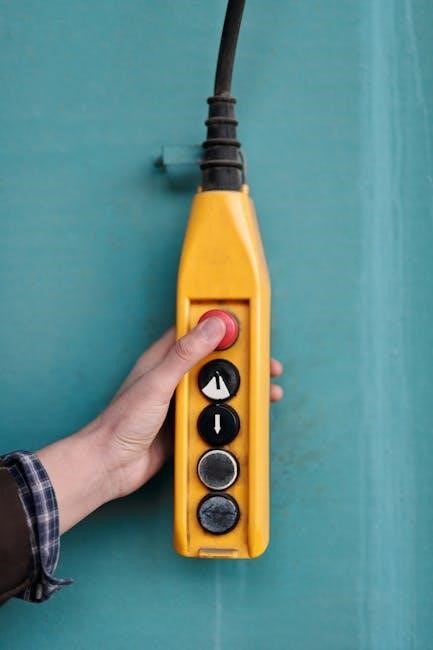
By adhering to these tips, you can maximize the performance and reliability of your marine air systems control panel, ensuring a comfortable and safe environment on board․
